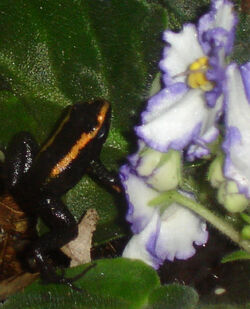| Phyllobates sp. aff. aurotaenia | |
|---|---|
 | |
| Physical description | |
| Binomial name | Phyllobates sp. aff. aurotaenia |
| Habitat | Tropical rainforest |
| Lifespan | 8-15+ years |
| Average Size | 3.5 cm (1.4 in) |
| Average weight | 3 grams |
| Diet | Insectivorous |
| Conservational Status | |
| Status | Endangered |
| IUCN status | 3.1 |
| Scientific classification | |
| Phylum | Chordata |
| Class | Amphibia |
| Order | Anura |
| Family | Dendrobatidae |
| Genus | Phyllobates |
| Species | P. sp. aff. aurotaenia |
| Distribution | |
| Distribution of species | Southeastern Colombia. |
Phyllobates sp. aff. aurotaenia is a temporary name given to a species of poison dart frog, formerly known as the "red" form of Phyllobates aurotaenia. It is morphologically similar to P. aurotaenia, but genetically it is more closely related to P. terribilis and bicolor. It is the third-most toxic of the poison dart frog species and the third-largest of its genus.
Poison[]
Phyllobates sp. aff. aurotaenia is the third-most toxic of the poison dart frogs. The frog primarily secretes allopumiliotoxin 267A through its skin, similar to the members of the lugubris subgenus. Like the members of the Phyllobates bicolor species group, however, it also secretes batrachotoxin through its skin, though in smaller amounts.
This species is lethally toxic. Simply touching an agitated adult frog can induce serious and often life-threatening neurological symptoms including high fever, loss of muscle control, convulsions, and even paralysis. Eating an adult P. sp. aff. aurotaenia may be fatal almost immediately, even for fairly large animals.
Although wild specimens are deadly, captive specimens lose their toxicity quickly. This suggests that they, too, take their toxins from their insect-rich diet.